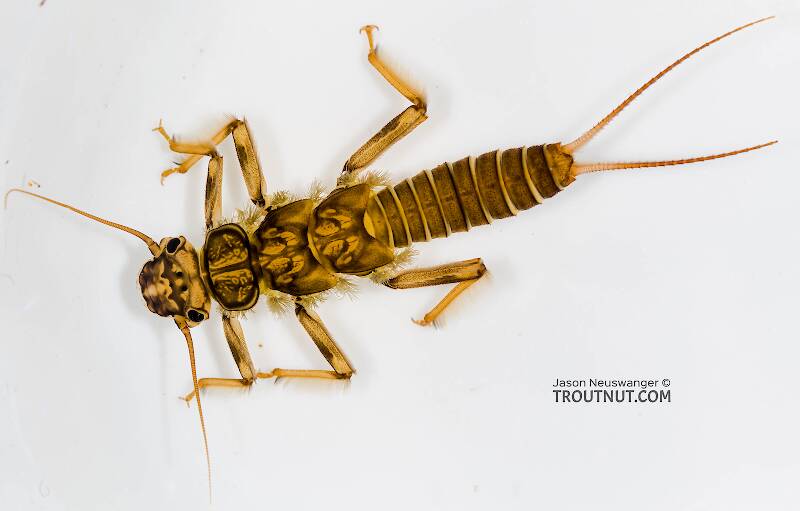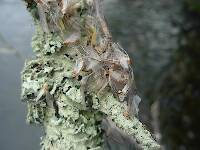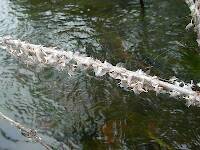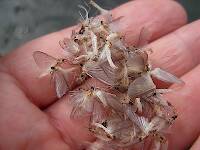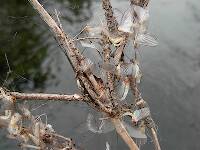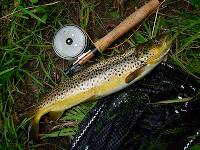
Hex Mayflies
Hexagenia limbata
The famous nocturnal Hex hatch of the Midwest (and a few other lucky locations) stirs to the surface mythically large brown trout that only touch streamers for the rest of the year.
Featured on the forum

Troutnut is a project started in 2003 by salmonid ecologist Jason "Troutnut" Neuswanger to help anglers and
fly tyers unabashedly embrace the entomological side of the sport. Learn more about Troutnut or
support the project for an enhanced experience here.
JumpNotZero on Sep 9, 2008September 9th, 2008, 4:06 am EDT
A friend and I were just fishing a small stream in northern Wisconsin and I saw a few white mayflys, about a size 12 (?)
I was struck by the incredibly long tails (TWO tails) on these buggers.
The LONG tails - is this conclusive evidence to say they were the E. leukons mayflies & nothing else? Thanks
I was struck by the incredibly long tails (TWO tails) on these buggers.
The LONG tails - is this conclusive evidence to say they were the E. leukons mayflies & nothing else? Thanks
Always quit when you're through.
GONZO on Sep 9, 2008September 9th, 2008, 7:30 am EDT
Tim,
In a word...no. I'd guess that the #12 white mayflies with the long tails were male spinners of a group commonly known as "cream Cahills" or "chalk Cahills" (genus Maccaffertium). Male mayflies typically have long tails and long forelegs in the spinner stage.
Ephoron is unusual in that the females have lost the molt into spinners. They mate, lay eggs, and die as duns. The females have three "normal length" tails. The two-tailed males do molt into spinners, and that molt is usually timed to coincide with the emergence of the female duns. In their seeming haste to shed the dun covering, the males are often seen flying with the whitish dun shuck still clinging to their tails. This led early researchers to (mistakenly) assume that they molted on the wing. The adult stage of Ephoron is very brief, and the best populations are usually found in larger, warmer streams and rivers where they create a frantic snowstorm of activity at dusk.
There is a fair amount of mistaken or misleading information about Ephoron in popular fly-fishing literature that often contributes to misidentification. However, once you become familiar with these distinctive mayflies, it is unlikely that you will mistake them for anything else. They have very broad wings that retain a cloudy whitish appearance (even in the male spinners). Most other mayflies have wings that become wholly or partly clear in the spinner stage. The tiny Caenis mayflies are about the only other commonly encountered mayflies that retain cloudy whitish wings in all adult stages, and they are easily distinguished by their size.
In addition, the Ephoron females have feeble atrophied legs that do not allow them to cling to vertical surfaces. (When they are attacted to lights, you will often see the females flopping helplessly on the ground.) The elongated forelegs of the males allow them to grasp the females during aerial mating, but the rather feeble hindlegs apparently function just well enough to allow the brief molt on streamside vegetation.
I hope that helps.
Best,
Lloyd
The LONG tails - is this conclusive evidence to say that they were the E. leukons mayflies & nothing else?
In a word...no. I'd guess that the #12 white mayflies with the long tails were male spinners of a group commonly known as "cream Cahills" or "chalk Cahills" (genus Maccaffertium). Male mayflies typically have long tails and long forelegs in the spinner stage.
Ephoron is unusual in that the females have lost the molt into spinners. They mate, lay eggs, and die as duns. The females have three "normal length" tails. The two-tailed males do molt into spinners, and that molt is usually timed to coincide with the emergence of the female duns. In their seeming haste to shed the dun covering, the males are often seen flying with the whitish dun shuck still clinging to their tails. This led early researchers to (mistakenly) assume that they molted on the wing. The adult stage of Ephoron is very brief, and the best populations are usually found in larger, warmer streams and rivers where they create a frantic snowstorm of activity at dusk.
There is a fair amount of mistaken or misleading information about Ephoron in popular fly-fishing literature that often contributes to misidentification. However, once you become familiar with these distinctive mayflies, it is unlikely that you will mistake them for anything else. They have very broad wings that retain a cloudy whitish appearance (even in the male spinners). Most other mayflies have wings that become wholly or partly clear in the spinner stage. The tiny Caenis mayflies are about the only other commonly encountered mayflies that retain cloudy whitish wings in all adult stages, and they are easily distinguished by their size.
In addition, the Ephoron females have feeble atrophied legs that do not allow them to cling to vertical surfaces. (When they are attacted to lights, you will often see the females flopping helplessly on the ground.) The elongated forelegs of the males allow them to grasp the females during aerial mating, but the rather feeble hindlegs apparently function just well enough to allow the brief molt on streamside vegetation.
I hope that helps.
Best,
Lloyd
Quick Reply
Related Discussions
Topic
Replies
Last Reply
5
Aug 7, 2007
by Wiflyfisher
by Wiflyfisher
2
Jul 9, 2018
by Martinlf
by Martinlf


